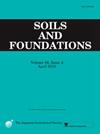Efficient and accurate methodologies for MCS-based probabilistic analysis of tunnel face stability
IF 3.3
2区 工程技术
Q2 ENGINEERING, GEOLOGICAL
引用次数: 0
Abstract
This paper proposes two strategies to perform efficient and accurate MCS-based probabilistic analysis of tunnel face stability. The first strategy takes the samples that have been evaluated by three-dimensional (3D) numerical simulations as classifiers to evaluate the MCS samples generated from the statistical parameters of uncertain variables. The number of 3D simulations can be significantly reduced to only 1 % or even 1‰ because most MCS samples are evaluated by the classifiers. This method is accurate because no approximation has been made in the evaluation process. The second strategy uses a previously established training dataset to construct an ensemble of metamodels to classify the MCS samples. Backpropagation Neural Network (BP) is utilized to construct a regression metamodel to predict the safety factors of each sample; the samples that are predicted to be near the limit state will be further evaluated by an adaptive classification metamodel constructed by the combination of K-Nearest Neighbor (KNN) and Support Vector Machine (SVM). KNN is used to search k training samples that have the smallest distances with the unknown sample, whereas SVM is used to construct a classification model to classify this sample using the k training samples. This strategy is much more efficient since a probabilistic analysis can be completed within a few seconds. Several illustrative examples are used to demonstrate the applications. Results show that the failure probabilities predicted by the ensemble of metamodels compare well with those determined according to direct MCS-based 3D numerical simulations, implying that the ensemble of metamodels is also accurate.
求助全文
约1分钟内获得全文
求助全文
来源期刊

Soils and Foundations
工程技术-地球科学综合
CiteScore
6.40
自引率
8.10%
发文量
99
审稿时长
5 months
期刊介绍:
Soils and Foundations is one of the leading journals in the field of soil mechanics and geotechnical engineering. It is the official journal of the Japanese Geotechnical Society (JGS)., The journal publishes a variety of original research paper, technical reports, technical notes, as well as the state-of-the-art reports upon invitation by the Editor, in the fields of soil and rock mechanics, geotechnical engineering, and environmental geotechnics. Since the publication of Volume 1, No.1 issue in June 1960, Soils and Foundations will celebrate the 60th anniversary in the year of 2020.
Soils and Foundations welcomes theoretical as well as practical work associated with the aforementioned field(s). Case studies that describe the original and interdisciplinary work applicable to geotechnical engineering are particularly encouraged. Discussions to each of the published articles are also welcomed in order to provide an avenue in which opinions of peers may be fed back or exchanged. In providing latest expertise on a specific topic, one issue out of six per year on average was allocated to include selected papers from the International Symposia which were held in Japan as well as overseas.
 求助内容:
求助内容: 应助结果提醒方式:
应助结果提醒方式:


